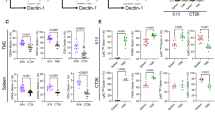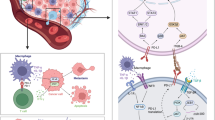Abstract
While the expression of either NKG2D ligands or PD-1 ligands has been reported in various types of cancers, the co-expression of the two sets of ligands in the same tumour tissues is still un-investigated. After examining 68 primary ovarian cancer samples, we observed around 80% of the co-expression in low grade serous and endometrioid ovarian cancer samples. We then constructed a dual CAR system that splits the conventional single-input of a 2nd generation CAR into two independent chimeric receptors, one composed of the NKG2D extracellular domain linked with DAP12 for T cell activation and another using the PD-1 extracellular domain linked with 4-1BB for costimulatory signal 2 input. Given the limitation of the low-affinity PD-1 receptor in recognizing cancer cells with low levels of PD-1 ligands, we also used a high-affinity scFv specific to PD-L1 in our combinatorial approach to expand the range of target cancer cells with different expression levels of PD-L1. The two types of dual CAR-T cells were generated through electroporation of non-viral piggyBac transposon plasmids and were effective in eliminating the target cancer cells. Especially, the dual CAR-T cells with anti-PD-L1 scFv were capable of eradicating established tumors in mouse models of peritoneal metastasis of colorectal cancer and ovarian cancer. Since both NKG2D ligands and PD-1 ligands have been marked as favourable cancer therapeutic targets, the new dual CAR-T cells developed in this study hold attractive application potential in treating metastatic peritoneal carcinoma.






Similar content being viewed by others
Data availability
The data that support the findings of this study are available from the corresponding author, Jianqing Zhu, upon reasonable request.
References
Cortes-Guiral D, Hubner M, Alyami M, Bhatt A, Ceelen W, Glehen O et al (2021) Primary and metastatic peritoneal surface malignancies. Nat Rev Dis Primers 7(1):91
Krishnamurthy A, Jimeno A (2018) Bispecific antibodies for cancer therapy: a review. Pharmacol Ther 185:122–134
Lazarova M, Wels WS, Steinle A (2020) Arming cytotoxic lymphocytes for cancer immunotherapy by means of the NKG2D/NKG2D-ligand system. Expert Opin Biol Ther 20(12):1491–1501
Fuertes MB, Domaica CI, Zwirner NW (2021) Leveraging NKG2D ligands in immuno-oncology. Front Immunol 12:713158
Ding H, Yang X, Wei Y (2018) Fusion proteins of NKG2D/NKG2DL in cancer immunotherapy. Int J Mol Sci 19(1):177
Sentman CL, Meehan KR (2014) NKG2D CARs as cell therapy for cancer. Cancer J 20(2):156–159
Demoulin B, Cook WJ, Murad J, Graber DJ, Sentman ML, Lonez C et al (2017) Exploiting natural killer group 2D receptors for CAR T-cell therapy. Future Oncol 13(18):1593–1605
Parihar R, Rivas C, Huynh M, Omer B, Lapteva N, Metelitsa LS et al (2019) NK cells expressing a chimeric activating receptor eliminate MDSCs and rescue impaired CAR-T cell activity against solid tumors. Cancer Immunol Res 7(3):363–375
Xiao L, Cen D, Gan H, Sun Y, Huang N, Xiong H et al (2019) Adoptive transfer of NKG2D CAR mRNA-engineered natural killer cells in colorectal cancer patients. Mol Ther 27(6):1114–1125
Obajdin J, Davies DM, Maher J (2020) Engineering of chimeric natural killer cell receptors to develop precision adoptive immunotherapies for cancer. Clin Exp Immunol 202(1):11–27
Ng YY, Tay JCK, Li Z, Wang J, Zhu J, Wang S (2021) T cells expressing NKG2D CAR with a DAP12 signaling domain stimulate lower cytokine production while effective in tumor eradication. Mol Ther 29(1):75–85
Tay JCK, Wang J, Du Z, Ng YY, Li Z, Ren Y et al (2021) Manufacturing NKG2D CAR-T cells with piggyBac transposon vectors and K562 artificial antigen-presenting cells. Mol Ther Methods Clin Dev 21:107–120
Du Z, Ng YY, Zha S, Wang S (2021) piggyBac system to co-express NKG2D CAR and IL-15 to augment the in vivo persistence and anti-AML activity of human peripheral blood NK cells. Mol Ther Methods Clin Dev 23:582–596
VanSeggelen H, Hammill JA, Dvorkin-Gheva A, Tantalo DG, Kwiecien JM, Denisova GF et al (2015) T cells engineered with chimeric antigen receptors targeting NKG2D ligands display lethal toxicity in mice. Mol Ther 23(10):1600–1610
Brandt LJB, Barnkob MB, Michaels YS, Heiselberg J, Barington T (2020) Emerging approaches for regulation and control of CAR T cells: a mini review. Front Immunol 11:326
Pauken KE, Torchia JA, Chaudhri A, Sharpe AH, Freeman GJ (2021) Emerging concepts in PD-1 checkpoint biology. Semin Immunol 52:101480
Liu X, Ranganathan R, Jiang S, Fang C, Sun J, Kim S et al (2016) A chimeric switch-receptor targeting PD1 augments the efficacy of second-generation CAR T cells in advanced solid tumors. Cancer Res 76(6):1578–1590
Schlenker R, Olguin-Contreras LF, Leisegang M, Schnappinger J, Disovic A, Ruhland S et al (2017) Chimeric PD-1:28 receptor upgrades low-avidity T cells and restores effector function of tumor-infiltrating lymphocytes for adoptive cell therapy. Cancer Res 77(13):3577–3590
Tay JC, Zha S, Wang S (2017) Chimeric switch receptor: switching for improved adoptive T-cell therapy against cancers. Immunotherapy 9(16):1339–1349
Rafiq S, Yeku OO, Jackson HJ, Purdon TJ, van Leeuwen DG, Drakes DJ et al (2018) Targeted delivery of a PD-1-blocking scFv by CAR-T cells enhances anti-tumor efficacy in vivo. Nat Biotechnol 36(9):847–856
Chen C, Gu YM, Zhang F, Zhang ZC, Zhang YT, He YD et al (2021) Construction of PD1/CD28 chimeric-switch receptor enhances anti-tumor ability of c-Met CAR-T in gastric cancer. Oncoimmunology 10(1):1901434
Liu H, Lei W, Zhang C, Yang C, Wei J, Guo Q et al (2021) CD19-specific CAR T cells that express a PD-1/CD28 chimeric switch-receptor are effective in patients with PD-L1-positive B-cell lymphoma. Clin Cancer Res 27(2):473–484
Liang Y, Liu H, Lu Z, Lei W, Zhang C, Li P et al (2021) CD19 CAR-T expressing PD-1/CD28 chimeric switch receptor as a salvage therapy for DLBCL patients treated with different CD19-directed CAR T-cell therapies. J Hematol Oncol 14(1):26
Feucht J, Sun J, Eyquem J, Ho YJ, Zhao Z, Leibold J et al (2019) Calibration of CAR activation potential directs alternative T cell fates and therapeutic potency. Nat Med 25(1):82–88
Sentman ML, Murad JM, Cook WJ, Wu MR, Reder J, Baumeister SH et al (2016) Mechanisms of acute toxicity in NKG2D chimeric antigen receptor T cell-treated mice. J Immunol 197(12):4674–4685
Hans Prenen JD et al (2021) Updated data from alloSHRINK phase I first-in-human study evaluating CYAD-101, an innovative non-gene edited allogeneic CAR-T in mCRC. ASCO GI J Clin Oncol 39:74
Schmiedel D, Mandelboim O (2018) NKG2D ligands-critical targets for cancer immune escape and therapy. Front Immunol 9:2040
Lopez-Soto A, Gonzalez S, Galluzzi L (2017) Soluble NKG2D ligands limit the efficacy of immune checkpoint blockade. Oncoimmunology 6(10):e1346766
Grosser R, Cherkassky L, Chintala N, Adusumilli PS (2019) Combination immunotherapy with CAR T cells and checkpoint blockade for the treatment of solid tumors. Cancer Cell 36(5):471–482
Smyth MJ, Ngiow SF, Ribas A, Teng MW (2016) Combination cancer immunotherapies tailored to the tumour microenvironment. Nat Rev Clin Oncol 13(3):143–158
Maute RL, Gordon SR, Mayer AT, McCracken MN, Natarajan A, Ring NG et al (2015) Engineering high-affinity PD-1 variants for optimized immunotherapy and immuno-PET imaging. Proc Natl Acad Sci USA 112(47):E6506–E6514
Cheng X, Veverka V, Radhakrishnan A, Waters LC, Muskett FW, Morgan SH et al (2013) Structure and interactions of the human programmed cell death 1 receptor. J Biol Chem 288(17):11771–11785
Funding
This work was supported by the Singapore Ministry of Health’s National Medical Research Council (NMRC/OFLCG/003/2018; MOH-000465-01); Agency for Science, Technology and Research, Singapore (IAF-PP:H19/01/a0/022); and by Cheetah Cell Therapeutics.
Author information
Authors and Affiliations
Contributions
SW and JZ contributed to the study conception and design. Material preparation, data collection and analysis were performed by GJ, YYN, JCKT, LX and ZD. The first draft of the manuscript was written by GJ, YYN and JCKT. SW and JZ commented on previous versions of the manuscript. All authors read and approved the final manuscript.
Corresponding author
Ethics declarations
Conflict of interest
The authors Shu Wang, Yu Yang Ng, Johan CK Tay have filed patent applications related to CAR technology and could potentially receive licensing royalties in future. Lin Xiao is employee of Cheetah Cell Therapeutics.
Additional information
Publisher's Note
Springer Nature remains neutral with regard to jurisdictional claims in published maps and institutional affiliations.
Supplementary Information
Below is the link to the electronic supplementary material.
Rights and permissions
About this article
Cite this article
Jiang, G., Ng, Y.Y., Tay, J.C.K. et al. Dual CAR-T cells to treat cancers co-expressing NKG2D and PD1 ligands in xenograft models of peritoneal metastasis. Cancer Immunol Immunother 72, 223–234 (2023). https://doi.org/10.1007/s00262-022-03247-9
Received:
Accepted:
Published:
Issue Date:
DOI: https://doi.org/10.1007/s00262-022-03247-9




